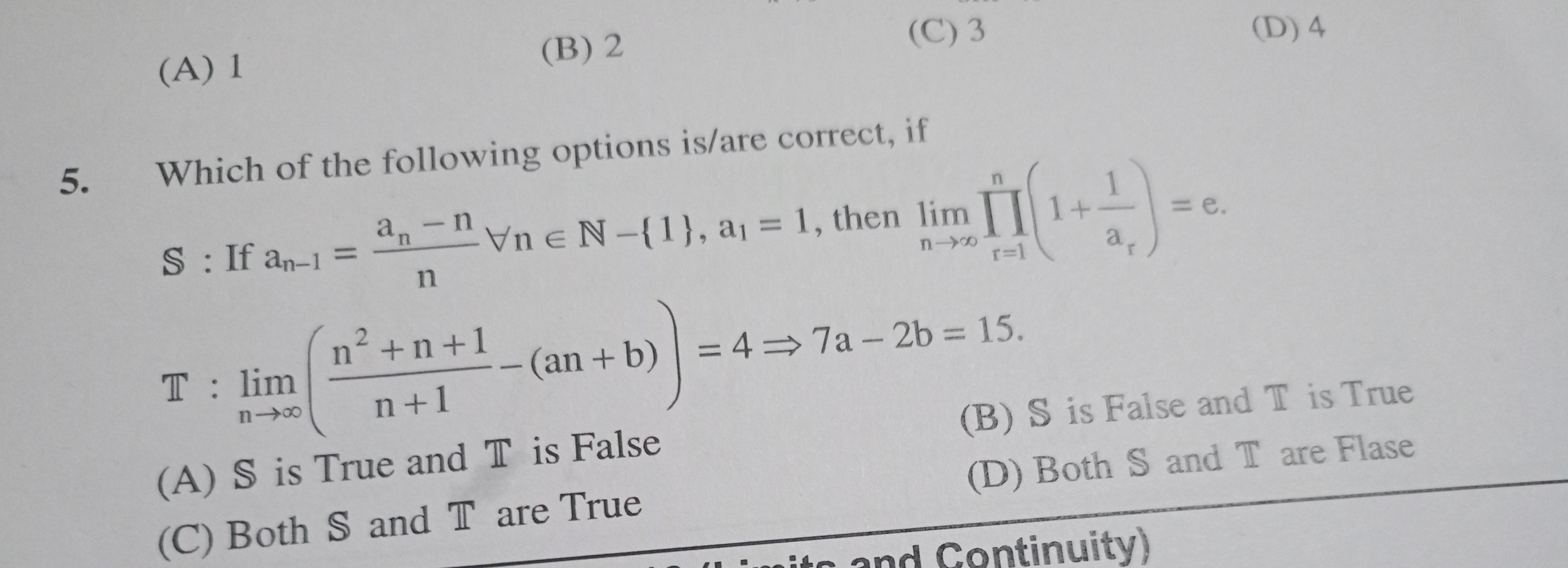Question
Question: Which of the following options is/are correct, if S : If $a_{n-1} = \frac{a_n-n}{n} \forall n \in N...
Which of the following options is/are correct, if
S : If an−1=nan−n∀n∈N−{1},a1=1, then limn→∞∏r=1n(1+ar1)=e.
T : limn→∞(n+1n2+n+1−(an+b))=4⇒7a−2b=15.

S is True and T is False
S is False and T is True
Both S and T are True
Both S and T are Flase
Both S and T are True
Solution
Statement S: The given recurrence relation is an−1=nan−n for n∈N−{1}, which means n≥2. This can be rewritten as nan−1=an−n, so an=nan−1+n=n(an−1+1) for n≥2. Given a1=1. Let's check if the relation an=n(an−1+1) holds for n=1. If we substitute n=1, we get a1=1(a0+1), which involves a0. The recurrence is given for n≥2. However, let's rewrite the relation as an−1+1=nan for n≥2. For n=2: a1+1=2a2. Since a1=1, 1+1=2a2⇒a2=4. For n=3: a2+1=3a3. Since a2=4, 4+1=3a3⇒a3=15. For n=4: a3+1=4a4. Since a3=15, 15+1=4a4⇒a4=64. The relation ar−1+1=rar holds for r≥2.Thisisequivalenttoa_r + 1 = \frac{a_{r+1}}{r+1}forr \ge 1$.
We need to evaluate the limit of the product Pn=∏r=1n(1+ar1) as n→∞. Pn=∏r=1narar+1. Using the relation ar+1=r+1ar+1 for r≥1, we have arar+1=arar+1/(r+1)=(r+1)arar+1. So, Pn=∏r=1n(r+1)arar+1=2a1a2⋅3a2a3⋅4a3a4⋅⋯⋅(n+1)anan+1. This is a telescoping product: Pn=(2⋅3⋅⋯⋅(n+1))⋅(a1⋅a2⋅⋯⋅an)a2⋅a3⋅⋯⋅an+1=(n+1)!a1an+1. Since a1=1, Pn=(n+1)!an+1.
From the relation an=n(an−1+1) for n≥2, we have n!an=n!n(an−1+1)=(n−1)!an−1+1 for n≥2. Let bn=n!an. Then bn=(n−1)!an−1+(n−1)!1=bn−1+(n−1)!1 for n≥2. This is a recurrence relation for bn. b2=b1+1!1 b3=b2+2!1=b1+1!1+2!1 bn=b1+∑k=1n−1k!1 for n≥2. b1=1!a1=11=1. So, bn=1+∑k=1n−1k!1=∑k=0n−1k!1 for n≥2. For n=1, b1=1!a1=1, and ∑k=01−1k!1=0!1=1. So the formula bn=∑k=0n−1k!1 holds for n≥1.
We have Pn=(n+1)!an+1=bn+1. So, Pn=∑k=0(n+1)−1k!1=∑k=0nk!1. We need to find limn→∞Pn=limn→∞∑k=0nk!1. This is the definition of the exponential constant e. limn→∞∑k=0nk!1=e. So, limn→∞∏r=1n(1+ar1)=e. Statement S is True.
Statement T: We are given limn→∞(n+1n2+n+1−(an+b))=4. Let's simplify the expression inside the limit: n+1n2+n+1−(an+b)=n+1n2+n+1−(an+b)(n+1) =n+1n2+n+1−(an2+an+bn+b) =n+1(1−a)n2+(1−a−b)n+(1−b). For the limit as n→∞ to be a finite value (4), the degree of the numerator must be less than or equal to the degree of the denominator. The degree of the denominator is 1. The degree of the numerator is 2. For the limit to be finite, the coefficient of n2 in the numerator must be zero. 1−a=0⇒a=1. Substitute a=1 into the expression: n+1(1−1)n2+(1−1−b)n+(1−b)=n+1−bn+(1−b). Now, evaluate the limit: limn→∞n+1−bn+(1−b). Divide numerator and denominator by n: limn→∞1+n1−b+n1−b=1+0−b+0=−b. We are given that this limit is 4. So, −b=4⇒b=−4. We found a=1 and b=−4. The statement T claims that if the limit is 4, then 7a−2b=15. Let's substitute the values of a and b we found into the expression 7a−2b: 7(1)−2(−4)=7+8=15. The condition 7a−2b=15 is satisfied with a=1 and b=−4. Therefore, Statement T is True.
Both Statement S and Statement T are True.
